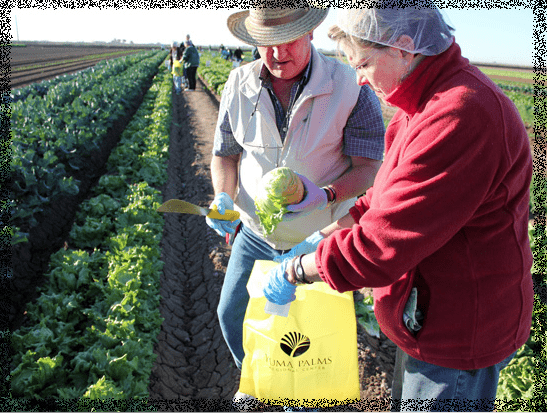An official with the Bureau of Labor Statistics, which prepares the unemployment numbers, said the bureau can’t explain the situation in Yuma. But they are learning that what’s extreme everywhere else has become Yuma’s normal
By Samantha Bare
Cronkite News

Photo by Yuma Visitors Bureau
WASHINGTON – In Detroit, where unemployment reached 16.1 percent in 2009, a quarter of the population left between 2000 and 2010.
In Flint, Mich., 2009 unemployment hit 14.5 and 18 percent of the population moved out over the decade while in Cleveland, unemployment peaked at 8.8 percent and 17.1 percent of the residents scrambled during the decade.
But when unemployment in Yuma ballooned to 22.9 percent in 2009, people were streaming in the other direction. From 2000 to 2010, Yuma’s population surged more than 20 percent, even as the jobless rate continued to climb.
In June, unemployment hit 27.9 percent – and people still show no sign of fleeing.
“They turn down job opportunities to stay in Yuma,” said Linda Jordan, executive director of the Yuma Visitors Bureau. “It’s the community and people, and all the things we have to offer.”
Yuma’s jobless rate far outpaces the national and state totals – 8.2 percent for each in June – and was second only to nearby El Centro, Calif., which had an unemployment rate of 28.2 percent for the month. The two towns have regularly swapped the top spot in the nation in recent years.
An official with the Bureau of Labor Statistics, which prepares the unemployment numbers, said the bureau can’t explain the situation in Yuma. But they are learning that what’s extreme everywhere else has become Yuma’s normal.
“It’s an extreme-weather area, an agricultural area, but there’s not much else we can really do to try to figure out what’s going on there,” said Tom Krolik, an economist with the BLS local-area unemployment section. “At some point you just become so accustomed to it that it becomes a fact on the ground, something that’s out of mind.”
Civic officials say the numbers don’t accurately portray the city.
“For a place that seems to be poor, there’s an awful lot of people waiting in line for a $5 coffee beverage at Starbucks,” said Dave Nash, spokesman for the city.
Questioning the numbers
And Julie Engel, president of the Greater Yuma Economic Development Corp., challenged the BLS numbers, saying the jobless rate is closer to 12 or 13 percent. She suspects a high number of people live in Yuma but work in California or Mexico, or live elsewhere but keep a Yuma post office box, and are illegally collecting Arizona unemployment, inflating the jobless count.
“States don’t talk to other states and the country doesn’t talk to other countries,” Engel said. “So as long as you have a physical address (in Yuma) – even if it’s just a post office box – and you’re not working in Yuma, you can collect (unemployment checks).”
Krolik said the BLS numbers are not “unimpeachable” but that the agency can only count what is reported to it.
“We have a standard set of procedures and we don’t have any basis for saying that certain unemployment insurance claims should not be counted,” he said. “There’s not much we can do about adjusting down the estimates.”
Even locals who see the unemployment first-hand are befuddled by the BLS number, which, seasonally adjusted, is still a staggering 27.3 percent.
“I don’t think anyone really has a grasp of what’s going on – how we can be at 29 percent (the May jobless rate) and not be a catastrophe,” said John Abarca, director of operations of the Yuma Community Food Bank.
But even at the lower range suggested by Engel, Yuma joblessness would still be 50 percent higher than the state and nation.
Snowbirds and sun
One possible explanation is the seasonal nature of the area’s economy, which is based largely on agriculture, tourism and spending at nearby military bases.
Jordan called Yuma the winter vegetable capital of the world, with an agriculture industry that provides an annual gross economic return of $3.2 billion. It also explains a higher unemployment rate during summers, Krolik said.
“Any time you have agricultural employment, you’re going to have seasonal variation in the unemployment rate that may seem extreme in certain months,” he said.
But even that is insufficient to explain what’s happening in Yuma, where in-season unemployment this year was still in the mid-20s.
And with temperatures routinely reaching triple digits in the summer months, Nash said there’s not much anyone can do to combat it.
“Not much grows well in that environment,” he said.
Summers also bring the tourism industry to a grinding halt. In winter, Yuma becomes home to almost 100,000 snowbirds who spent $603.3 million and supported 6,330 jobs in the area in 2011.
Nash said the effects of a seasonal economy are felt by all businesses in the region.
“There’s a very nice German restaurant a block away from where I work. I wish it was open all year long, but … they’re open seasonally,” he said. “So what does that do to the wait staff, kitchen staff. What are they doing the rest of the year?”
Snowbirds nest in the area from September to April to take advantage of the mild temperatures and bountiful sunshine that won Yuma the title of “sunniest place on Earth” in the Guinness World Records.
Local officials insist the outlook is sunny, too, despite the current situation. For example, Engel said, tourism continues to grow as more snowbirds flock to the area.
“Yuma continues to grow; our sales tax revenues and hospitality revenues continue to grow,” she said. “We’ve added 11 new hotels in the last seven years, so that industry is thriving quite well.”
Struggling for work
Improvements can’t come too soon for Yuma resident Stacy Cook, who is one of the unemployed. When she was told the town’s unemployment nearing 30 percent, she asked, “Is that all?”
Cook agrees Yuma has a lot to offer, but said she is struggling to find work.
“You cannot find a job in the summertime – I’ve tried,” she said.
“Either you’re underqualified or overqualified,” she said. “There’s not a whole lot I can’t do, but I don’t have the qualifications on paper.”
Cook said she has a clean background – “not even speeding tickets” – but without the ability to speak Spanish and with limited daycare options for her 4-year-old son, there aren’t many jobs she can apply for. She said her lack of a high school diploma has also hindered her job search.
Cook cannot leave the area to look for work because her husband, who is based at Marine Corps Air Station Yuma, is currently deployed.
“A lot are stuck here with the military,” Cook said.
But people get stuck for far more reasons than just the military, said John Morales, executive director of the Yuma Private Industry Council.
“If people could leave, that’s one thing,” he said. “Leaving means you would have the financial resources to leave your home, if it’s not underwater.”
He said those who do end up leaving – college students – often return years later to raise families in the safe, clean environment they grew up in.
Morales said other factors might be holding Yuma back economically. A lack of educational attainment is one.
In Yuma County, 71.6 percent of the population has a high school degree or higher, as opposed to 85 percent statewide, according to the Census Bureau’s 2010 American Community Survey.
“We have a large pool of willing people who want to go to work but they may not have the skills to match up with jobs that are becoming more technologically sophisticated,” Morales said.
Frustration and hope
Abarca said he sees the frustrations of those “willing people” first-hand at the food bank, which is serving 24,000 people a month – double what was being served a year ago. But he agrees with local officials who are optimistic about turning the consistently high unemployment around.
“We’ve seen it over the past few years, that the (unemployment) peaks have been higher than normal,” Abarca said. “But because of the potential that exists here, I think everyone’s still optimistic that we’ll get through this and tighten our britches.”
Greater Yuma Economic Development Corp.’s Engel said she sees the opportunity for continued growth in the area.
“I see us growing. We have grown; we will continue to grow. Our location will continue to be an asset,” she said. “We have a lot of resources that make us attractive to industries.”
Until then, the high unemployment remains – and remains a mystery to economists, residents and officials alike.
“Although the recession is supposed to be over, it sure doesn’t look like it here,” Morales said.
A Top-10 no one wants to make
Metro areas with the highest unemployment rates in June, according to the federal Bureau of Labor Statistics’ Metropolitan Area Employment and Unemployment estimates:
• El Centro, Calif., 28.2 percent
• Yuma, Ariz., 27.9 percent
• Yuba City and Merced, Calif., (tied) 17.8 percent
• Modesto, Calif., 15.8 percent
• Hanford-Corcoran, Calif., 15.5 percent
• Fresno, Calif., 15.3 percent
• Visalia-Porterville, Calif., 15.1 percent
• Stockton, Calif., 14.9 percent
• Madera-Chowchilla, Calif., 14.6 percent
• Vineland-Millville-Bridgeton, N.J., 14 percent












